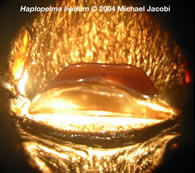Sexing A Tarantula
© 2008-2013, Michael Jacobi and TARANTULAS.com
Introduction
In most tarantulas the female and male look almost identical throughout most of their lives. That is until a male reaches maturity where he may look drastically different than he did prior to his maturing (or ultimate) molt. Since females live much longer than males, they are more desirable to the pet keeper. However, telling the two sexes apart can be very difficult, especially for the novice keeper. People soon learn to recognize the characteristics of a mature male, but it can be much harder to distinguish between an immature male and a female, especially in young tarantulas.
The Mature Male
 When a male has his ultimate (final) molt and reaches sexual maturity he is a completely different spider. During this ultimate molting process he obtained his sexual organs, which are bulbs (emboli, plural; embolus, singular) on the end of his pedipalps that are used to transfer sperm from his sperm web to the female. In many species males also have tibial spurs, which are "mating hooks" on the underside of the tibia (or long segment) of the first pair of walking legs and are used to engage the female's fangs during mating. These two structures, the tibial apophysis (or spur) and the embolus (or palpal bulb) are the things to look for to determine if you have a mature male. In some species the transformation is even more obvious, as mature males have distinctly different colors and patterns, and are much smaller and more thinly built and "leggy" than females.
When a male has his ultimate (final) molt and reaches sexual maturity he is a completely different spider. During this ultimate molting process he obtained his sexual organs, which are bulbs (emboli, plural; embolus, singular) on the end of his pedipalps that are used to transfer sperm from his sperm web to the female. In many species males also have tibial spurs, which are "mating hooks" on the underside of the tibia (or long segment) of the first pair of walking legs and are used to engage the female's fangs during mating. These two structures, the tibial apophysis (or spur) and the embolus (or palpal bulb) are the things to look for to determine if you have a mature male. In some species the transformation is even more obvious, as mature males have distinctly different colors and patterns, and are much smaller and more thinly built and "leggy" than females.
Male Or Female?
Although mature males may be obvious once you learn the characteristics, they often look very similar to the female prior to the ultimate molt. It is true that adult females are generally larger (often significantly so) and more heavily built than males, and that their chelicerae (the "jaws" that terminate in fangs at the front of the body) are proportionately broader. But these are subtle differences that require some experience to use and several specimens to compare. They can even fool the experienced keeper. Below we discuss the most accurate method of sex determination, the microscopic examination of molted specimen to detect the absence or presence of spermathecae only found in females. We also mention a good method of visually sexing tarantulas by careful examination of the epigastric furrow region on the underside of the abdomen [or opisthosoma] and link to an informative page on another site that details this method. Although it can be difficult to use this method reliably in young tarantulas, even novice keepers can often sex their adult tarantulas by careful study of the illustrations provided.
Microscopic Examination of Molts
 The most accurate method of determining the gender of a live tarantula is to examine the interior of the abdominal portion of its exuvium (molted skin or exoskeleton). A female tarantula sheds the spermathecae lining along with the rest of her exoskeleton and an experienced examiner can look for the presence of spermathecae, which is the sperm storage receptacle of the female. This usually requires the use of a stereo dissecting microscope with lighting above and below the stage, but spermathecae are visible to the naked eye with most skins of large adult tarantulas. Examining exuvia (molts) for the presence or absence of spermathecae requires experience, softening the skin, and carefully unfolding and untwisting the abdominal skin so that the four book lungs and the genital opening are stetched flat. Spermathecae lie above the genital opening [epigynum] between the anterior book lungs. The spermathecae are surrounded by the uterus externus. In some species, the males have accessory organs that can be mistaken for spermathecae by inexperienced examiners and carefully looking for the uterus externus is important. Click here to visit Michael Jacobi's Exotic Fauna website and learn more about this method and how to send him your tarantula exuvia for free sex determination.
The most accurate method of determining the gender of a live tarantula is to examine the interior of the abdominal portion of its exuvium (molted skin or exoskeleton). A female tarantula sheds the spermathecae lining along with the rest of her exoskeleton and an experienced examiner can look for the presence of spermathecae, which is the sperm storage receptacle of the female. This usually requires the use of a stereo dissecting microscope with lighting above and below the stage, but spermathecae are visible to the naked eye with most skins of large adult tarantulas. Examining exuvia (molts) for the presence or absence of spermathecae requires experience, softening the skin, and carefully unfolding and untwisting the abdominal skin so that the four book lungs and the genital opening are stetched flat. Spermathecae lie above the genital opening [epigynum] between the anterior book lungs. The spermathecae are surrounded by the uterus externus. In some species, the males have accessory organs that can be mistaken for spermathecae by inexperienced examiners and carefully looking for the uterus externus is important. Click here to visit Michael Jacobi's Exotic Fauna website and learn more about this method and how to send him your tarantula exuvia for free sex determination.
Epigastric Furrow and The Epiandrous Fusillae Method
Male tarantulas, even those who have yet to reach their ultimate molt, have additional spinnerets [fusillae] anterior to the epigastric furrow that are connected to silk-producing epiandrous glands. It is believed that these auxiliary organs are used in sperm web production. The presence [male] or absence [female] of these fusillae is a reliable indicator of gender. For more information and illustrations on this "epiandrous fusillae" method of sexing tarantulas, click here to visit Rick West's birdspiders.com and read Mark Hart's "How to Determine the Sex of Your Tarantula".



